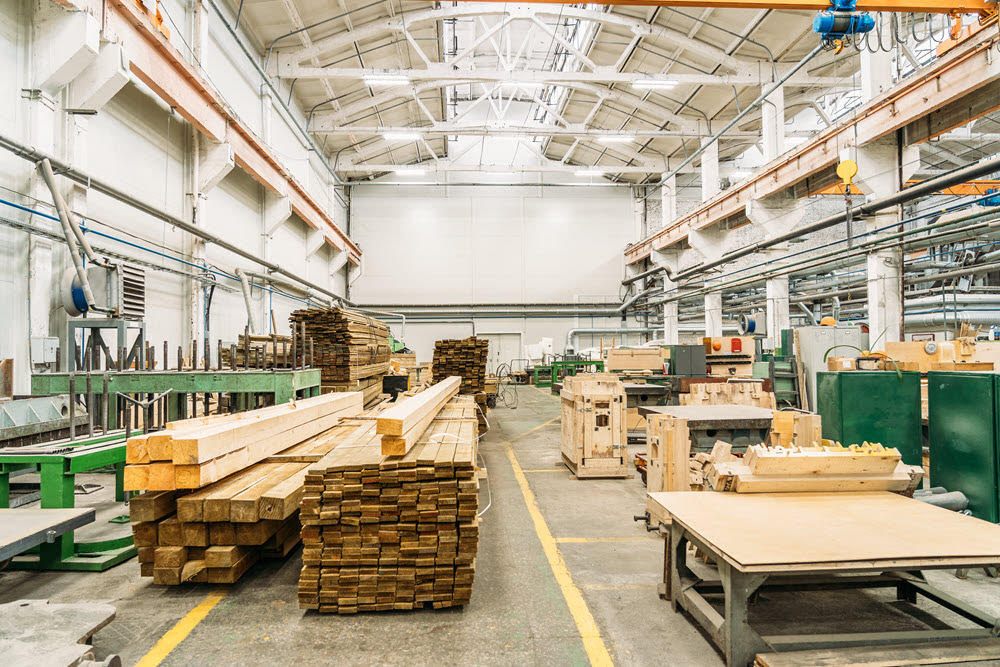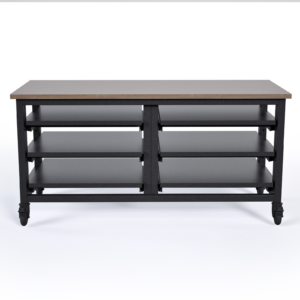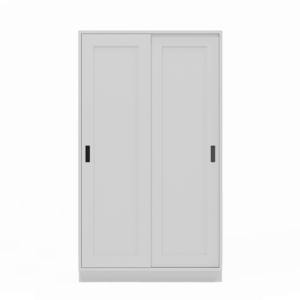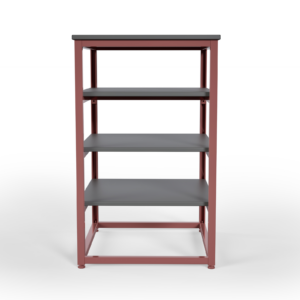Back in February, we first wrote about the shortage of computer chips bedeviling the automobile manufacturing industry – at the time, we dubbed it the “chip-pocalypse.”
But soon afterward, we began to hear from supply chain managers that, yes, while chips were indeed in critically short supply, the bigger story was that, in the words of one manufacturing exec in the Midwest, “chips were an easy scapegoat – it’s not just chips, everything in the supply chain is jammed up now.”
So what are the main reasons that many raw materials are in short supply, and when will things return to normal?
We decided to focus on what is happening with material supplies in our industry, furniture manufacturing, to see what is going on and how supplies might ease up in the coming months.
But first, here is a useful tip: if you are contemplating a new order, talk to your Formaspace Design Consultant now about placing your order earlier than usual to avoid the impact of longer lead times for some materials. And if you are flexible on material choices, your Design Consultant can also advise you on which material options have shorter lead times.
Steel and other Metal Raw Materials
Here at our factory headquarters in Austin, Texas, we use a lot of carbon steel to fabricate the famous heavy-duty frames found in all Formaspace workbenches, tables, workstations, and desks.

We also source a lot of stainless steel for making furniture destined for settings such as cleanrooms, laboratories, as well as hospitality settings, such as food service kitchens.
As part of our Made-in-America manufacturing philosophy, we use locally sourced steel and other metals, which gives us a significant lead time advantage over other manufacturers that are reliant on overseas metal suppliers.
Nonetheless, there is increasing pressure on steel and other metal supply chains overall due to production cutbacks during the pandemic, which let inventory levels fall off significantly.
As a result, many steel mills and aluminum foundries and mills – especially those in overseas locations where vaccination rates are still very low – are struggling to reboot production levels to keep up with rapidly increasing demand.
US tariffs on foreign steel and metal imports, first introduced by the Trump administration to encourage American steel manufacturing, are still in place. The tariffs have given domestic metal manufacturers increased pricing power.
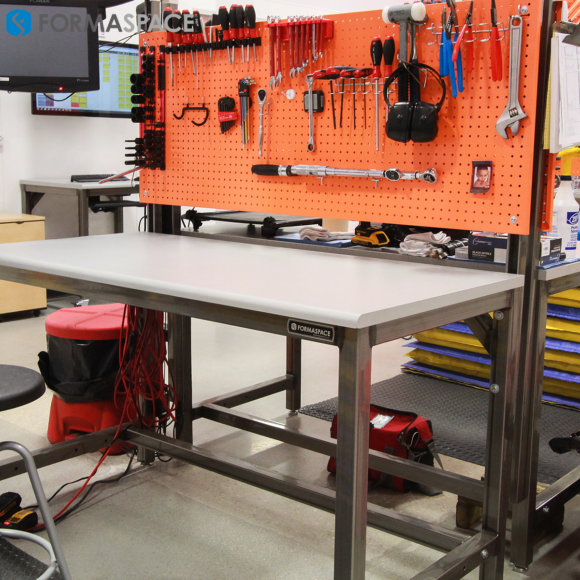
For example, the CRU Index for carbon steel, a widely-used benchmark from the Commodities Research Unit (CRU), which tracks the future commodity prices of Hot-Rolled Coil Steel (HRC) produced in the Midwest, has leaped from around $450 a ton last year to around $1,650 this month – a 360% increase.
Reasons for Concern |
Reasons for Optimism |
| Prices for raw metal materials are way up, hot-rolled coil steel (used in extruded frames, for example) is up 360% compared to last year.
Demand for metals bottomed out during 2020 due to low demand, causing mills and foundries to cut production. But demand has returned, creating major shortages. Many overseas mills and foundries are still experiencing high levels of Covid infections among their populations, which is slowing a return to full production capacity. US tariffs on imported metal products keep overall metal prices higher in the US. Demand for metal products is also rising due to increased construction activity. If the proposed Infrastructure Bill is passed, demand for metals used in bridges, wiring, etc. will increase further. Other metals not commonly used in furniture production, such as copper and lithium used in green energy projects, are also in short supply and could slow down efforts to build new green infrastructure projects to address climate change. |
Vaccination programs are helping protect workers in the US, Europe, and the UK, allowing their workforces to return to full strength.
Higher prices are helping metals manufacturers restart factories to increase production, which should eventually lead to lower prices. The Biden administration may elect to ease US tariffs on imported metal products, which would reduce raw material prices for US manufacturers. |
Engineered Materials and Laminates
Here at Formaspace, we offer our customers a wide variety of material options – even our so-called standard products can be customized by selecting among different work surface material options to meet the unique requirement of your application.
These material options include work surfaces made from high-pressure laminate (HPL); long-lasting engineered epoxy; durable, chemically-resistant phenolic resin; soft HDPE (to prevent scratching products); ESD protective surfaces (to prevent damaging sensitive microelectronic circuits); stainless steel (discussed earlier); and even maple hardwood surfaces (discussed in the next section on wood-based products).
Reasons for Concern |
Reasons for Optimism |
|
Some work surface materials, such as epoxy countertops, are currently experiencing significantly longer lead times than normal – in some cases, twice as long as compared with April 2020. |
Production lead times should begin to drop as factories return to full-scale production and ease the backlog of orders. Talk to your Formaspace Design Consultant about placing your order early, as well as looking at material options to minimize lead times. |
Wood-based Raw Material Products
Compared to many furniture manufacturers, Formaspace (and our sister entity, Formaspace Contract, which creates custom solutions for the office, hospitality, and other related markets) does not use a significant amount of wood or wood-based raw materials in making furniture – we typically use heavy-duty steel to frame our furniture products.
The one exception is specialty woodwork surfaces, including our popular hardwood maple tops used in both office and industrial applications, or our bespoke hand-made desks, credenzas, and conference tables that feature unique custom wood selections, such as live-edge walnut.
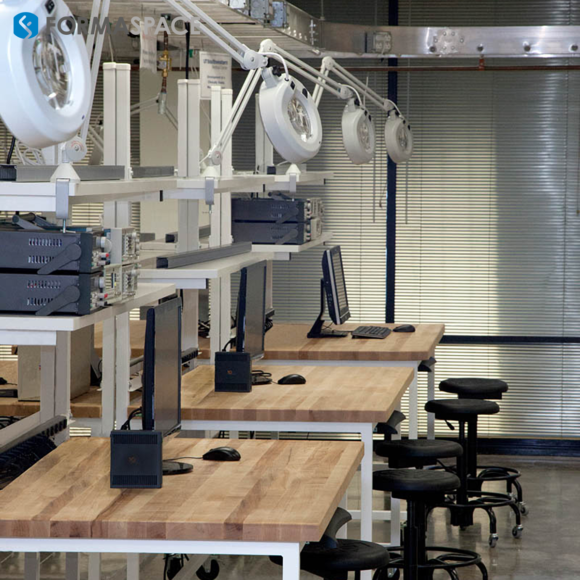
This is in contrast with other furniture manufacturers (especially those making products for residential or hospitality markets) that may heavily rely on white pine, chipboard, or MDF materials that are hidden underneath upholstered or plastic laminated surfaces.
But it’s the adjacent construction market that is suffering the greatest impact from the overall shortage of dimensioned lumber and other wood and wood-based raw materials.
Construction industry analysts point to the sharp increase in lumber prices (especially plywood*) that is boosting the average cost of a new home by $36,000, according to the National Association of Home Builders.
According to researchers at North Carolina State University’s College of Natural Resources, the price of lumber hit an all-time high in May 2021 (at nearly $1,700 per thousand board feet), which is a 400% price increase compared to May 2020.
*Paying around $10 for a ½ inch sheet of plywood is a distant memory. Searching for a sheet of standard plywood today, the retail price at Home Depot is $22. According to US BLS statistics, the Producer Price Index cost of plywood dipped to 195 basis points in December 2019, in May 2021, it had jumped up by 200% to 392.
Why the big increase in wood prices?
As with other commodities, production of wood products dropped last year during the height of the pandemic.
Yet demand stayed steady. Since last year, homeowners have been on a home-improvement spending spree, creating larger, more comfortable spaces for living and working at home during the lockdown. Demand for new homes is also up, fueled by low interest rates and driven by a desire to move away from city centers during the pandemic.
While demand remains strong, the recovery has been spotty. The wood industry has had difficulty catching up on production, with further disruptions taking place this past February due to especially harsh cold winter weather (and the associated power outages) in the Southern states that disrupted tree harvests.
Softwood lumber from Canada is also in short supply. The Trump administration added a 20% tariff to Canadian software lumber imports before the pandemic (now reduced to 9%), which has decreased the demand for Canadian softwood products. But production in the forested areas of British Columbia, the primary source of Canadian wood exports, has dropped considerably as well, beset by one environmental disaster after another, including forest fires, beetle infestations, and abnormally slow spruce tree growth.
Fortunately, if lumber futures are to be believed, we may be past the peak in lumber prices, though it will take many months before prices at the retail level return to normal.
Reasons for Concern |
Reasons for Optimism |
|
Production of wood products slowed significantly during the pandemic. Demand for home improvements and new housing outside urban areas has driven up demand (and prices) for lumber and wood-based products US tariffs on Canadian softwood lumber have reduced their importation significantly. The tariff was 20% and is now 9%. Meanwhile, Canadian lumber production is down due to fires, beetles, and slow-growing trees. Worsening drought conditions in the West could impact the forestry industry. |
Formaspace can obtain hardwood materials, such as our popular maple, though lead times have increased slightly. Talk to your Formaspace Design Consultant for the latest information and about placing your order early. Prices for future contracts for lumber commodities are trending downward, which indicates the wood products industry’s efforts to increase production should help ease supply shortages (and reduce prices) in the coming months. |
Supply of Plastics and Surface Finishes, such as Paints
Adding to the misery for manufactures, plastic-based raw materials are also currently in short supply.
Part of that disruption is due to the shutdown of petrochemical plants along the Gulf coast during February of this year when electricity and natural gas supplies to refineries and chemical plants were cut off during the “big freeze.”
According to analysts at NCSU, the cold weather shutdown this past winter had a bigger impact on petrochemical production than the last large-scale disruption – Hurricane Harvey, which flooded much of Houston and coastal Texas in 2017.
Fortunately, here at Formaspace, we don’t typically use that many plastic components in our furniture products compared to other manufacturers.
There are a couple of exceptions. The first is for clear plastic divider accessories, made of Plexiglas or similar products, which saw exceptional high demand throughout 2020, which led to high lead times for the raw plastic. The second exception is for specialty work surfaces made of HDPE, which is often specified for assembly lines and shipping stations because the soft plastic work surface won’t scratch finished goods.
On the other hand, Formaspace does use significant amounts of paint, powder-coatings, and other materials to protect our steel frame furniture products, so we’re taking additional steps to ensure we have sufficient inventory on hand to meet our production requirements.

In the meantime, the price we are paying for paint and other surface treatment materials is going up.
To give you an idea of what to expect from the paint and specialty chemical industry, CNN reports that Sherwin-Williams plans to increase its retail paint prices by 7% in August.
Reasons for Concern |
Reasons for Optimism |
|
Many paint products and other surface treatments rely on specialty chemical products, and shutdowns of refining and chemical plan operations along the Gulf Coast during the “big freeze” in February have tightened inventories. |
Formaspace has increased its inventory of supplies on hand. Paint suppliers will increase production to take advantage of increased demand (and higher prices) which should help increase supply over the coming months. |
Foam Padding and Upholstery Fabric Supplies
Furniture manufacturers who use foam padding for seating, bedding, and other upholstery applications suffered a major setback earlier this year.
The two US factories owned by EverChem that supply the foam padding industry with a key ingredient – toluene diisocyanate (TDI) – used to make foam products are both located along the Gulf Coast, and, you guessed it, both factories were taken offline in February when the “big freeze” cut access to the electric and natural gas supplies.
The resulting foam shortage forced many domestic furniture manufacturers, particularly those North Carolina-based companies making residential furniture, to shut down temporarily.
This latest foam shortage added insult to injury for an industry hoping to return to full production – a critical milestone for major residential furniture manufacturing companies, such as La-Z-Boy, who shut down their factories in April 2020 and furloughed 70% of their workers due to the pandemic.
Supplies of textiles for upholstered furniture are also a concern. Many of these fabrics come from overseas, and after the Trump administration applied a tariff to Chinese imports (before the outbreak of the Covid pandemic), many furniture companies switched from Chinese fabric suppliers to ones based in Vietnam.
As we’ve seen in other industries, many Vietnamese fabric factories also shut down in 2020 due to low demand. Now that demand has returned, many of these foreign factories are having difficulty finding workers to bring production levels to pre-pandemic levels.
Reasons for Concern |
Reasons for Optimism |
|
A single chemical used for making foam padding was in short supply after the cold freeze in February shut down two factories. Overseas textile factories, such as those in Vietnam, are having difficulty finding workers to bring their production back to pre-pandemic levels. The result is higher prices and longer lead times. |
Aside from some space dividers offered by Formaspace Contract, most of the furniture manufactured by Formaspace does not use foam padding or textile-based upholstery. |
Transportation Delays and Increase Shipping Costs
Finally, we should address an issue that is affecting all manufacturers, not just Formaspace and the furniture industry.
The Coronavirus disrupted nearly all forms of transportation throughout 2020, and now that demand for products is returning, logistics companies can’t keep up.
For those manufacturers depending on raw materials or product components made in Asia, there are significant delays in transporting containers to the US West coast – and prices have skyrocketed by 300% or more from last year’s lows, with some spot prices now jumping to $6,000 to even $10,000 per container.
And that’s assuming you can even book a container. Many of them are in the wrong place at the wrong time, and the issue was amplified by the multi-day shutdown of the Suez Canal earlier this year.
If you are lucky enough to book a container from Asia, there is more cost and delay once the container reaches ports on the US West Coast, which have been beset by delays in unloading shipments onto trucks and rail cars.
As we saw during the recent Colonial Pipeline ransomware crisis, there is very little slack in the supply of available truck drivers. The reasons for this are diverse: for example, many older truckers elected to retire during the pandemic, and younger drivers who would normally enter the field haven’t been able to get the required training for their commercial driver’s licenses due to a backlog caused by driving schools shutting down during the pandemic.
Meanwhile, the wood shortage we discussed earlier is affecting logistics as well.
Packaging materials, including cardboard boxes and shipping cartons – which are made from wood-based materials – are now in short supply.
So too are wooden pallets used to transport goods on trucks, shipping containers, and railcars. The price of pallets, if you can get them, was up by 400% in May.
Reasons for Concern |
Reasons for Optimism |
|
Overseas containers are in short supply, and if they are available at all, the spot prices are at record highs. Trucking companies are having difficulty finding enough drivers to meet demand. Packing materials, including cardboard and cartons, are in short supply, along with wooden pallets. |
Fortunately, Formaspace does not rely on overseas imports, aside from sourcing some small hardware components not available domestically. Formaspace’s central location in Austin, Texas, helps reduce our shipping times to customers across the US. Asian logistics companies are ordering more containers and commissioning more cargo ships, the high prices and delays will eventually come to an end, perhaps by late 2022. The US Department of Transportation has temporarily relaxed truck driver requirements, allowing each driver to work a longer day. |
Find your local Formaspace Design Consultant
If you are contemplating remodeling an existing facility or embarking on a new construction project, the best time to contact your Formaspace Design Consultant is now.
Why?
Your Design Consultant can help you get your furniture order on track so that you meet your project deadlines.
Give them a call today and find out why leading companies, from Apple, Google, and Twitter to Capital One, Dell Computer, and SpaceX, choose Formaspace for their custom furniture solutions.


